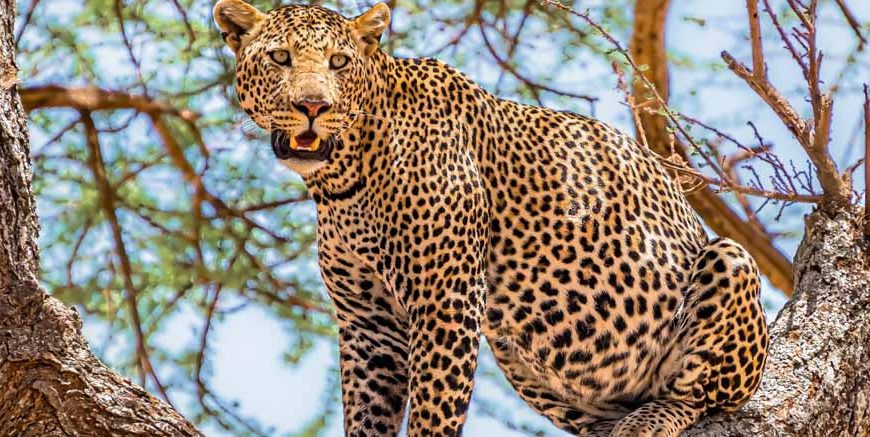Leopards are one of the most interesting animals especially in the wild, as their beauty, speed, and trickiness inspire and terrify. Young ones who are eager to know about the particulars of leopards have leapt on some helpful leopard information to pique their interest in these beautiful jungle animals called cats. These interesting facts about leopards will surely help you whether you are studying the animal world in school or simply enjoy learning and are filled with the wonder of nature.
Leopards: Description, Behavior, Life, Distribution: Wild Cats with Grace at Scale
Like lions, tigers, and jaguars, leopards belong to the family of the ‘big cats’. One of the first things you will need to know about leopards is that they are great climbers and swimmers. Their strong bodies with powerful legs and sharp claws enable them to adapt to different ecological settings including areas dominated by thick forests and the endless grasslands.
Unlike other species of big cats, leopards are solitary animals, which means that they like to be by themselves. They are also very territorial and will aggressively protect their territory from other animals. They are distributed in various regions including but not limited to Africa, India and some regions of Asia, which makes them very flexible in different climates and environments.
Interesting Facts About Leopards
Now that you know a little bit about leopards, let’s dive into some science through fun facts about these amazing animals.
- Leopards Can Be Seen in More Than One Color
- Leopards Are Great Climbers
- Leopards Have Unique Spots
- Leopards Hunt During the Night
- Leopards Are Generalists and High Trophic Level Carnivores
- Leopards Are Very Busy Creatures And Beast
The majority of leopards are covered in the usual golden-yellow fur with black spots, also termed rosettes. However, not all leopards look alike. In some other regions, there are leopards which are melanin-enhanced, darker in color and these are called black leopards. Such leopards range in pigmentation because they’re just as spotted, save for the fact that their dense dark fur means nothing.
One of the best climbers amongst the big cats is the leopard as it is one of the few members of the feline family that enjoys hanging around in tree branches. To protect their meals from scavengers such as hyenas, leopards often hoist their kill onto trees. This not only demonstrates their overeducation but even more of their intellect. They also do not leave out the arms of the trees as resting sites or views to escape from the hard sun.
Like fingerprints, no two leopards have the same universal patterns of spots, skills that everyone seems to possess just like every human. These appendage spots which are referred to as rosettes ensure that leopards are proficient hunters by enabling them to camouflage in their respective environment. Further, no matter whether they are among the trees or trying to stalk through overgrown grass, the coats serve them perfectly as a cover.
Leopards hunt for food at night since they are one important leopard fact about these cats. This means that this particular species of large cats will need to hunt for their prey at night when it is cooler. They do this in total darkness relying on their eyes and nose. Their movements are very silent which ranks them among the best killer animals in the jungle.
The main prey for leopards is antelopes, deer and monkeys, but the leopards are not so selective. Acceptable for the leopards are not only large vengeful animals. They catch everything that’s within reach, birds, reptiles and sometimes even fish! Indeed, leopards are classified as opportunistic hunters which means that they will eat almost anything that they can find, giving them a wider range of habitats.
Although leopards are not able to compete with cheetahs in terms of speed, they are quite quick. In short bursts, leopards can run at speeds of up to 58 kilometers per hour. On the other hand, the physical abilities of the leopards are what makes them very unique. They can actually lift and carry heavy prey and climb up trees with them hefting loads beyond their body weight which is an animal ability few possess.
A Brief Description of the Driving Location of Leopards
Leopards inhabit different types of regions that include dry deserts, rain forests and even grasslands and savannas. In the Indian subcontinent, the leopard is one of the popular sighted large cats, especially in wildlife reserves and national parks. Due to the number of ecosystems, leopards are quite adaptable and can be spotted in various nations including India, China, Sri Lanka and certain regions in Africa.
Leopards are essentially forest animals but they have been known to occupy semi-barren regions. Also, they are visible even close to human habitation. This flexibility to exist in different weather conditions is what makes them quite proficient hunters.
Leopard Information: Lifespan and Behavior
In the wild leopards have a lifespan of between 12 and 17 years. However in captivity, away from their natural predators and guaranteeing constant meals, the age can be approximated to 20 years or more. Leopards are highly secretive and thick-skinned animals. They do not often roar like lions and tigers for they have low soft growls or grunts when communicating. As far as hunting is concerned, leopards use patience and stay at one spot for dozens of minutes or hours before they pounce on the target.
Leopards are also very protective of their territories. While a male leopard’s territorial range may encompass that of a number of females, he will fight with men, intruding in his domain. A female leopard will rear cubs alone and is solely responsible for their upbringing. A leopard cub stays with its mother in order to learn essential survival techniques for about two years before it is ready to start living alone.
Conservation status of leopards.
Although leopards are present in various parts of the planet, their population is on the decline because of diminishing habitats, hunting, and interactions with people. There are legislative protections against the poaching of leopards in India against the Wildlife Protection Act of 1972 enforced with many conservation measures combating poaching. Unfortunately, it still becomes rather difficult as human economies develop and the areas with leopards are invaded.
Various Park institutions run campaigns to save such spectacular creatures and avoid any form of extinction that would make the species endangered.
Few Lines About Leopards’ Interrelation With Society
Leopards have been mentioned in a number of cultures including Indian culture. Besides being physically graceful and strong, and shrouded with awe, leopards have often served as icons of might. A number of tribal societies in India, for example, Maharashtra have tales and myths of these beautiful beasts. Leopards are even found in the forms of craft, textiles, art and the local crafts proving their significant place in the culture.
Now here it is, some of the amazing leopard information that indicates their awesomeness which is at the top. Leopards are one of the perfect killers of all predators in nature since they are cunning, powerful, and intelligent. No matter where the cats are lounging on the branches of trees or what position they are in during the chase of their prey, there are efficient cats who impress all of us. All these efforts on conservation are achievements and one day, it will come to pass that young people will appreciate and understand more about leopards as we do today.
At EuroKids, our objective is to foster curiosity and instil the attitude of learning. We implement our programs in such a way that every child finds something interesting no matter what age group they are in. If your child likes animals like a leopard or if he/she is fascinated by the wonders of science, EuroKids is there to help them. Please visit the nearest EuroKids centre to understand all the ways we may help your child blossom to their potential!















